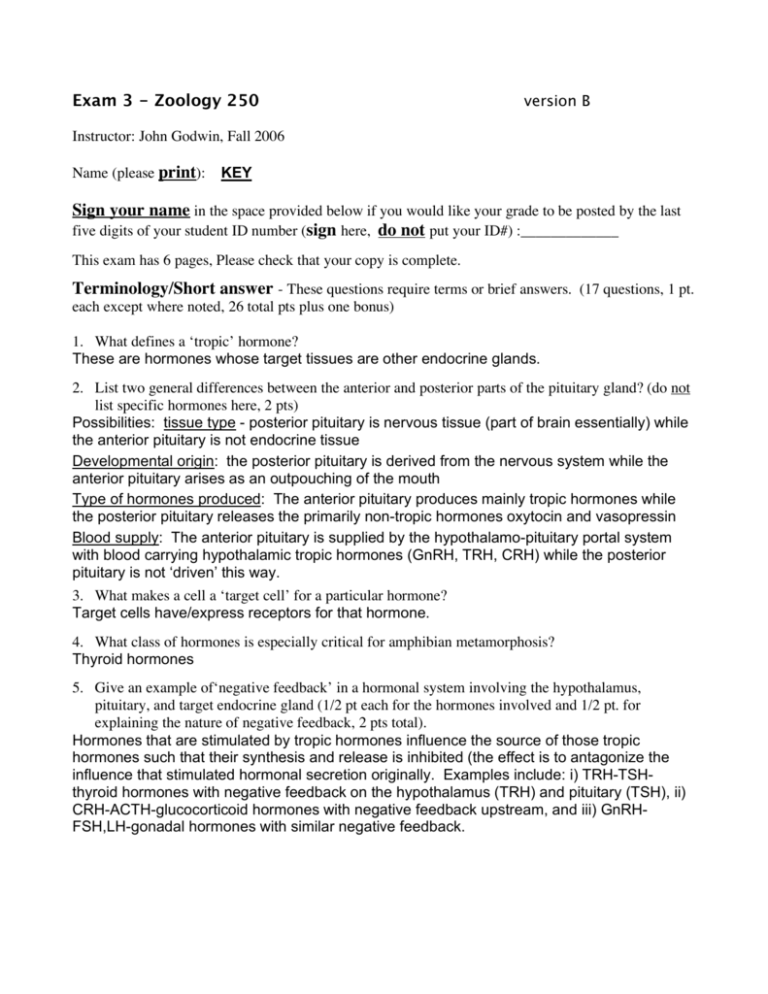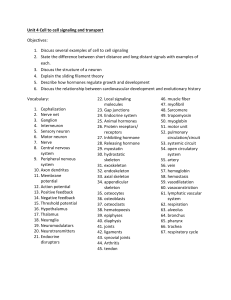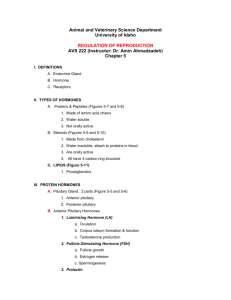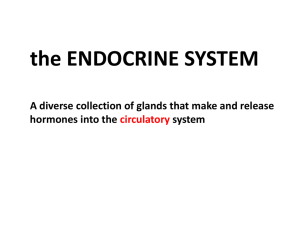Exam 3B key
advertisement

Exam 3 - Zoology 250 version B Instructor: John Godwin, Fall 2006 Name (please print): KEY Sign your name in the space provided below if you would like your grade to be posted by the last five digits of your student ID number (sign here, do not put your ID#) :_____________ This exam has 6 pages, Please check that your copy is complete. Terminology/Short answer - These questions require terms or brief answers. (17 questions, 1 pt. each except where noted, 26 total pts plus one bonus) 1. What defines a ‘tropic’ hormone? These are hormones whose target tissues are other endocrine glands. 2. List two general differences between the anterior and posterior parts of the pituitary gland? (do not list specific hormones here, 2 pts) Possibilities: tissue type - posterior pituitary is nervous tissue (part of brain essentially) while the anterior pituitary is not endocrine tissue Developmental origin: the posterior pituitary is derived from the nervous system while the anterior pituitary arises as an outpouching of the mouth Type of hormones produced: The anterior pituitary produces mainly tropic hormones while the posterior pituitary releases the primarily non-tropic hormones oxytocin and vasopressin Blood supply: The anterior pituitary is supplied by the hypothalamo-pituitary portal system with blood carrying hypothalamic tropic hormones (GnRH, TRH, CRH) while the posterior pituitary is not ‘driven’ this way. 3. What makes a cell a ‘target cell’ for a particular hormone? Target cells have/express receptors for that hormone. 4. What class of hormones is especially critical for amphibian metamorphosis? Thyroid hormones 5. Give an example of‘negative feedback’ in a hormonal system involving the hypothalamus, pituitary, and target endocrine gland (1/2 pt each for the hormones involved and 1/2 pt. for explaining the nature of negative feedback, 2 pts total). Hormones that are stimulated by tropic hormones influence the source of those tropic hormones such that their synthesis and release is inhibited (the effect is to antagonize the influence that stimulated hormonal secretion originally. Examples include: i) TRH-TSHthyroid hormones with negative feedback on the hypothalamus (TRH) and pituitary (TSH), ii) CRH-ACTH-glucocorticoid hormones with negative feedback upstream, and iii) GnRHFSH,LH-gonadal hormones with similar negative feedback. 6. The actions of protein hormones are characterized by tremendous amplification of the original signal following hormones binding to receptors. Picking one of the two main 2nd messenger systems, briefly describe what accounts for this amplification of the original signal? cAMP system: One hormone molecule can activate adenylyl cyclase, which generates lots of cAMP, and each cAMP can activate a number of downstream enzymes, which can in turn activate a number of targets and so on in a ‘phosphorylation cascade’ (see p. 213) Inositol triphosphate: following hormone binding, phospholipase C (PLC) generates large amounts of IP3, which acts to release many Ca2+ ions from the ER In both cases here, there is substantial and rapid amplification of the original hormonal signal. 7. Diabetes creates the unusual situation where tissues do not get sufficient glucose despite very high levels of glucose being present in the blood? What accounts for this problem? (there are two possibilities here – give one) i) Insulin is not being produced by the pancreas (type I diabetes) ii) Insulin is being produced, but cells cannot respond (adult-onset or type II diabetes) 8. What specific hormone is released in response to falling glucose concentrations and causes glycogen breakdown in the liver? What specific cell type produces this hormone? (2 pts total) Glucagon, pancreatic α cells 9. What is meant by the term ‘endocrine disruption’? Related to this, why does it matter that many endocrine disrupting compounds are lipophilic? (1 pt each, 2 pts total) This occurs when foreign compounds, typically of man-made origin, interfere with the function of the endocrine system. Many of these substances are lipophilic, which allows bioaccumulation in tissues (i.e., a build up in levels over time) 10. Explain the difference between sex determination and sexual differentiation. Sex determination is the process that ‘decides’ what sex an individual will become while sex differentiation is the developmental process of ‘becoming’ that sex. 11. Lack of a functional androgen receptor can result in the development of a female-like phenotype in XY individuals. What very basic feature of mammalian sexual development does this example illustrate? It is said that the ‘default’ sex for mammals is female, with embryos developing female-typical features unless active masculinizing processes alter this path (birds are the opposite). 12. What is meant by the term ‘heterogametic sex’? This is the sex than contributes one of two different sex chromosomes in the gametes (X or Y for male mammals, Z or W for female birds). 13. Correctly label the parts of the neuron, associated cells, or specialized ‘junctions’ on the figure below here by entering your answer for each lettered structure in the spaces provided on the left side (1/2 pt each for A-D, 3 pts total for this question). A: dendrites A B: Schwann cells or oligodendrocytes (refers to the cell type shown, 2 answers are possible here) C: axon D C D : synapse (refers to this ‘meeting point’ of the two neurons shown) B E. Last part of Q.16: What is the functional importance of the cells labeled ‘D’ in the figure above? (this can be answered in 2-3 words, 1 pt here) These cells provide electrical insulation that increases conduction speed. 14. Action potentials travel in only one direction down neurons as indicated in the figure above. What feature of the action potential prevents it from being propagated back in the other direction? (i.e., prevents it from traveling backwards) The refractory period 15. List three things you would need to show to demonstrate that a particular chemical was a neurotransmitter (1 pt each, 3 pts total) - present at synapse and released on stimulation - compound must cause excitation or inhibition of postsynaptic cell - there must be some mechanism to ‘stop’ the signal (degradation of transmitter or reuptake from the synapse) 16. An excitatory influence on a neuron at a chemical synapse would be expected to cause what very specific electrical change across the neuron membrane? (looking for a specific term here – 1 pt) What is the opposite electrical change termed (e.g., the change an inhibitory neurotransmitter would cause – 1 pt). - Excitatory Post Synaptic Potential or EPSP (half credit given for ‘depolarization’) - Inhibitory Post Synaptic Potential or IPSP (half credit given for ‘hyperpolarization’) Note: This was strongly emphasized in class and is a key feature of neurotransmitter actions. 17. What does the term ‘cephalization’ refer to? The localization or development of the main part of the nervous system and sense organs in the head Bonus: What is the embryonic origin of the cells labeled ‘B’ in the figure for question 13 above? Neural crest cells Multiple Choice Section (23 ‘real’ questions plus Q#1, 23 pts total) 1. I am doing version __ of this exam: A) a, B) b 2. Hormones affecting a cell in the immediate vicinity of the cell producing and releasing the hormone would be termed a _____ action. a) Pheromonal, b) Exocrine, c) Paracrine 3. Steroid hormones are _______ and act primarily by ___________ a) Hydrophilic, altering gene expression after binding intracellular receptors b) Hydrophilic, activating second messenger systems after binding cell surface receptors c) Hydrophobic, activating second messenger systems after binding cell surface receptors d) Hydrophobic, altering gene expression after binding intracellular receptors 4. You apply a hormone to a population of cells you are studying and observe that it induces rapid increases in intracellular Ca2+ concentrations. Based on this, which of the following is NOT true? a) This hormone binds a cell surface receptor b) The receptor for this hormone interacts with a G protein following hormone binding c) This hormone activates the enzyme adenyl cyclase d) This hormone activates the enzyme phospholipase C e) This hormone causes a rise in intracellular levels of inositol triphosphate 5. Which of the following hormones stimulates uterine contractions during the birth process in mammals? a) Oxytocin, b) Vasopressin, c) Adrenocorticotropin, d) Gonadotropin, e) Urocortin 6. Under stimulation from CRH, the pituitary secretes ______. a) Vasopressin, b) LH, c) FSH, d) ACTH, e) TSH 7. Dihydrotestosterone is the most potent androgen in terms of masculinizing the external phenotype. This hormone is created by: a) Conversion of estrogen by the enzyme aromatase b) Conversion of testosterone by the enzyme aromatase c) Conversion of estrogen by the enzyme 5α-reductase d) Conversion of testosterone by the enzyme 5α-reductase e) Conversion of testosterone by the enzyme monoamine oxidase 8. Maintenance of the uterine lining during pregnancy in mammals requires which of the following hormones? a) Estradiol, b) Testosterone, c) Cortisol, d) Aldosterone, e) Progesterone 9. It is possible to determine the likelihood of a compound interacting with our endocrine system simply by examining its chemical structure. a) This statement is true, b) This statement is false 10. Neurons are the most abundant type of cell in our brain. a) This statement is true, b) This statement is false Membrane potential (mV) Questions 11 through 18 refer to the diagram below: Time (mSeconds) 11. At time point #1, which of the following is TRUE? a) Leakage of sodium ions out of the neuron is greater than leakage of potassium ions into the neuron b) Leakage of sodium ions into the neuron is greater than leakage of potassium ions out of the neuron c) Leakage of potassium ions out of the neuron is greater than leakage of sodium ions into the neuron d) Leakage of potassium ions into the neuron is greater than leakage of sodium ions out of the neuron e) Leakage of potassium ions out of the neuron is equivalent to leakage of sodium ions into the neuron 12. At time point #2, which of the following is TRUE? a) Both the activation and inactivation gates of the voltage-gated sodium channels are open b) The voltage-gated potassium channel is open c) The potassium leak channels are closed d) The sodium leak channels are closed e) The sodium/potassium pump has reversed directions and is pumping sodium in and potassium out 13. The dashed line indicated by the number 5 on the diagram is referred to as the: a) Resting membrane potential, b) Action potential, c) Cationic potential d) Refractory potential, e) Threshold potential 14. Applying a toxin that blocked non-voltage gated potassium channels (i.e., the potassium ‘leak channels’) at the point indicated by #1 would cause the membrane potential to be: a) Less negative b) More negative c) No change would be observed 15. The effect of blocking potassum leak channels referred to in the question above is termed: a) Hyperpolarization, b) Depolarization, c) Repolarization, d) Active transport e) None of the above 16. Imagine you apply a toxin that blocks the voltage-gated potassium channel in this neuron. At or before which of the numbered points would you expect the action potential to be disrupted? a) 1, b) 2, c) 3, d) 4, e) 6 17. At which of the numbered points would you observe a positive feedback process occurring? a) 1, b) 2, c) 3, d) 4, e) all of the above 18. What stops the rapid rise in membrane potential between points 2 and 3? a) The inactivation gate of the sodium channel closes b) The activation gate of the sodium channel closes c) The voltage-gated potassium channel opens d) A and B are correct e) A and C are correct 19. Rising intracellular levels of which ion are necessary for neurotransmitter release from a neuron? a) K+, b) Cl-, c) Mg2+, d) HCO3-, e) Ca2+ 20. Imagine you are walking at night and hear a sound in the bushes nearby. Nearly instantly, your _______ nervous system is activated and releases the neurotransmitter _____. a) Sympathetic, acetylcholine b) Sympathetic, norepinephrine c) Parasympathetic, acetylcholine d) Parasympathetic, norepinephrine e) Somatic, norepinephrine 21. The activation referred to in the question above has which of the following effects a) Pupil dilation b) Relaxation of the bronchi c) Stimulation of smooth muscle in the stomach and intestines d) All of the above e) A and B, but not C 22. Which of the following choices has the appropriate matching of functions to brain region for vertebrates other than mammals? a) Vision – forebrain, Balance and Hearing – hindbrain, Olfaction – midbrain b) Vision – midbrain, Balance and Hearing – hindbrain, Olfaction – forebrain c) Vision – hindbrain, Balance and Hearing – midbrain, Olfaction – forebrain d) Vision – forebrain, Balance and Hearing – hindbrain, Olfaction – forebrain e) Vision, Balance and Hearing, and Olfaction are all processed in the hindbrain 23. Processing of sensory information in mammals has been ‘taken over’ by which major brain region in mammals? a) Telencephalon, b) Diencephalon, c) Mesencephalon, d) Metencephalon, e) Myelencephalon 24. The process by which neuron cell bodies end up on the outside of the forebrain in adulthood in mammals like ourselves is termed: a) myelination, b) cephalization, c) canalization, d) corticosteroidogenesis, e) corticalization








